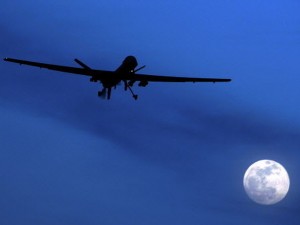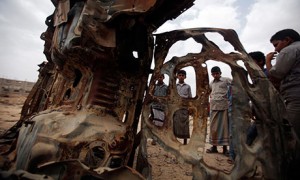
U.S. Predator drone flies over Kandahar Air Field (Source: AP Photo/Kirsty Wigglesworth)
Over the past ten days, the Obama administration has carried out a series of synchronized drone airstrikes in Yemeni airspace as part of an effort to disrupt an al-Qaeda terrorism plot that has forced the closure of American embassies around the world. The incursions have brought an abrupt end to a seven-week stretch with no strikes—one of the longest lulls since the drone attacks began to heat up on the Arabian Peninsula in early 2011. According to Yemeni security officials, the latest strike in southern Yemen on Wednesday killed seven alleged militants, while a strike on Tuesday reportedly killed four militants in the impoverished nation’s Marib province. The Yemeni government is crediting the U.S. with this and a multitude of other drone airstrikes, yet as is protocol, the Obama administration has refrained from formally recognizing the operations.
The consistent refusal to take credit for actions, such as those in Yemen, stem in large part from the fact that the U.S. government runs two separate drone programs. The military’s version, which is publically recognized as an extension of conventional warfare, operates in documented war zones like Afghanistan and Iraq. The CIA’s program, aimed at the universal engagement of terror suspects, operates on the Arabian Peninsula and the Horn of Africa, especially in Somalia, Pakistan, and Yemen. This latter program is tightly classified, and the intelligence agency declines to provide any information to the public regarding logistics.
How does this all work, legally?
In the days following September 11th, 2001 a secret Memorandum of Notification was signed by President Bush, giving the CIA the right to kill supposed members of al-Qaeda and their associates anywhere in the world. Congress embraced this dispatch, quickly passing a bill called the Authorization for Use of Military Force. Modeled on Israel’s position against terrorism, the bill gave the U.S. government legal justification for employing lethal force against agents of terror in “anticipatory” self-defense. By classifying terrorism as an act of war as opposed to a crime, the New York Times has determined that the Bush Administration was able to circumvent legal constrains requiring the government to give terror suspects due process.

The White House has made it clear that it must be the Yemeni military, not the U.S., that eventually regains territories lost to Islamist insurgents.
For the U.S. government to legally target civilian terror suspects under international law, it has to define a terrorist group as a direct participant in hostilities. “There must be no reasonable alternative such as capture,” articulates Professor Michael Walzer, author of Just and Unjust Wars, and “force must be proportional in accordance with Just War Theory.”[i] Many lawyers have taken an in-depth look at America’s drone programs in Pakistan and Yemen, and have determined that they are legal. However, defining who is important enough to kill is difficult says John Radsan, a former lawyer in the CIA’s office of general counsel. Radsan, now a Professor at William Mitchell College of Law, clarifies “you can’t target someone just because he visited an al-Qaeda Web site. But you also don’t want to wait until they’re about to detonate a bomb. It’s a sliding scale.” After all, the cost of bad ground intelligence can be high in collateral damage. As of the start of 2013, the civilian casualty rate is estimated to be between 4% and 8.5% in Yemen, roughly comparable with the rates from operations in Pakistan—5.5%—last year.[ii]
More drones over the Yemeni skies
Like Pakistan, Iraq, Afghanistan and Somalia before it, drones are allowing their operators to rapidly transform the geopolitical landscape in Yemen. The expansion of the drone campaign in Yemen, to which Washington silently agreed to early last year, underlines the difficulty that the Obama administration faces in balancing concerns about al-Qaeda’s growing foothold in southeast Yemen against fears that greater CIA involvement could propel the U.S. into another regional conflict. Consequently, the drone program is controversial in Yemen, where many opposition leaders and intelligence officials believe that strikes will give al-Qaeda a powerful recruiting tool.
According to correspondence from the Wall Street Journal and top-ranking Yemeni officials, President Obama initiated talks about expanding drone operations last September, amid the political instability of Yemen’s anti-regime uprising. The talks gained further traction this spring, after Abdu Rabu Mansour Hadi officially took over as Head of State. With the Yemeni campaign rising in intensity, the frequency of U.S. strikes is expected to skyrocket, reflecting an American assessment that increased activity is necessary while Yemen’s military reasserts its authority across the country. For the White House has made it clear that it must be the Yemeni military, not the U.S., that eventually regains territories lost to Islamist insurgents.

A car destroyed by a drone strike targeting suspected al-Qaida militants in the province of Shabwa, Yemen. Photograph: Khaled Abdullah/Reuters
The situation on the ground
Officially, the Obama administration has taken credit for killing 16 key al-Qaeda militants in Yemen. However, counting drone attacks and airstrikes in Yemen is complicated because it is difficult for villagers to distinguish between attacks launched from fighter jets and from drones. To make data collection on these strikes even more difficult, according to the New York Times, diplomatic cables released by the transparency watchdog website WikiLeaks reveal that the Yemani government occasionally takes credit for airstrikes that were in fact being carried out by the U.S. In one such January 2010 cable, then-Yemeni President Ali Abdullah Saleh told then-General David Petraeus “we’ll continue saying that the bombs are ours, not yours.”
Professor Gregory D. Johnsen, a leading Yemen expert at Princeton University, notes that while the covert drone war is driving a fast-rising casualty rate, it is not clear if is it significantly weakening the AQAP—Yemen’s al-Qaeda in the Arabian Peninsula. According to Johnsen’s most recent research, the AQAP has grown dramatically in size during the Obama Administration from 200-300 loosely organized rebels to more than 1000 fighters. Additionally, the AQAP control “significant portions of territory in southern Yemen,” and see themselves as “the de facto government in areas under [their] control.” This positive correlation between AQAP support and drone strikes prompted Johnsen to ask: “What happens if this ‘missile surge’ doesn’t work? What happens next?”
Regardless of what does happen next, the recent exponential increase in U.S. drone activity in Yemen has raised new questions about who is being targeted, and if such targeting is proving effective. According to The Washington Post, a review of strikes so far may suggest that the current administration has “embraced a broader definition of what constitutes a terrorism threat that warrants a lethal response.” Bruce Riedel of the Brookings Institution has been following these issues closely for the past few years. He sees the choices facing Obama as “exceedingly hard,” because for Reidel “the reason the administration continues to use [drones] is obvious: it doesn’t really have anything else.”
[i] Walzer, Michael., 2006. Just And Unjust Wars: A Moral Argument with Historical Illustrations. New York: Basic Books.
[ii] West, Eleanor T., 2011. “Yemen: Hearts, Minds & Al-Qaida.” World Policy Journal, 28 (2), 122-142.
Related articles in the category Middle East and North Africa and Warfare

Trackbacks / Pings